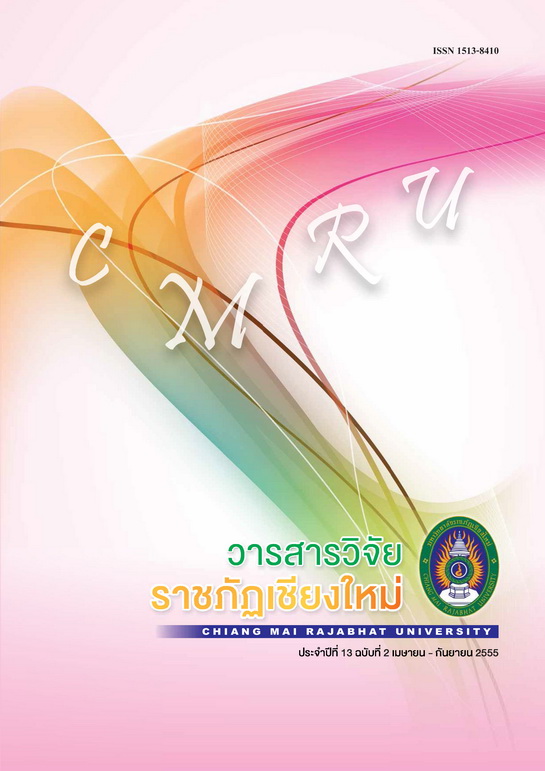การศึกษาประสิทธิภาพของการใช้ ออดิโอ-อาร็่ทิคิวเลชันโมเดล เพื่อพัฒนาการออกเสียงเสียดแทรกในกลุ่มนักศึกษาไทย
DOI:
https://doi.org/10.14456/rcmrj.2012.96113Keywords:
การออกเสียง เสียงเสียดแทรก, นักศึกษาไทย, ประสิทธิภาพ, ออดิโอ-อาร์ทิคิวเลชัน, pronunciation, fricative sound, adult Thai students, effectiveness, Audio-articulationAbstract
การวิจัยนี้มีวัตถุประสงค์เพื่อศึกษาประสิทธิภาพของการใช้ Audioarticulation Model ในการพัฒนาการออกเสียงเสียดแทรกในกลุ่มนักศึกษาไทยและเจตคติที่ได้รับจากการสอนด้วยวิธีดังกล่าว นักศึกษากลุ่มทดลองคือ นักศึกษาชั้นปีที่สาม คณะครุศาสตร์ มหาวิทยาลัยราชภัฏเชียงใหม่สาขาวิชาภาษาอังกฤษ จำนวน 8 คน ในการแกอบรมโดยใช้เทคนิค AAM เป็นระยะเวลา 12 สัปดาห์งานวิจัยในครั้งนี้เป็นการศึกษาแบบการวิจัยกึ่งทดลอง ซึ่งประกอบด้วยการวิเคราะห์เชิงปริมาณและการวิเคราะห์เชิงคุณภาพ กลุ่มตัวอย่างทำการทดสอบก่อนและหลังเรียน ตลอดระยะเวลาในการฝึกอบรมกลุ่มตัวอย่างต้องเขียนสรุปความรู้หลังการเรียน และในชั่วโมงสุดท้ายของการเรียนกลุ่มตัวอย่างทำแบบสอบถามวัดระดับเจตคติต่อการเรียนการสอน Mann-Whitney บ Test ได้รับการปรับใช้เพื่อการวิเคราะห์พัฒนาการด้านการออกเสียง ระบบ รหัสปลายเปิดได้รับการนำมาใช้เพื่อวิเคราะห์แบบสอบถาม นอกจากนี้กลุ่มตัวอย่างจำนวนสามคนได้รับการสุ่มเลือกเป็นกลุ่ม nested cases ในการวิเคราะห์ปฏิกิริยาของกลุ่มตัวอย่างต่อการเรียนด้วยเทคนิค AAM และ เพื่อสนับสนุนผลการวิจัย
ผลการวิจัยพบว่า กลุ่มตัวอย่างมีพัฒนาการด้านการออกเสียงที่ดีขึนอย่างมีนัยสำคัญทางสถิติที่ระดับ .05 อีกทั้งมีเจตคติที่ดีต่อการใช้ AAM และผลการศึกษาในกลุ่ม nested caseจำนวนสามคนพบว่า ระยะเวลาและเทคนิคที่ใช้ในการแกอบรมสามารถช่วยให้กลุ่มตัวอย่างมีพัฒนาการด้านการออกเสียงเสียดแทรกที่ดีขึน
A Study of the Efectiveness of an Audioarticulation Model in Improving Thai Learners’ Pronunciation of Fricative Sounds
The objectives of this research were to investigate the effectiveness of the Audioarticulation model (AAM) in improving the pronunciation of English fricative sounds among adult Thai stadents and their attitude toward the AAM. Eight third year English Education students from Chiangmai Rajabhat University participated in the pronunciation training course based on AAM for 12 weeks. The study was quasi-experimental design with both quantitative and qualitative data analyses. The participants took pronunciation tests before and after the training course. During the course, they completed the learning logs and a questionnaire developed for measuring their attitudes toward the course. The Mann-Whiney บ Test was applied to detect whether the participants have made any improvement in pronouncing English fricative sounds. The open coding system was used as a guideline for the analysis of the questionnaire. The three participants were purposive selected to be nested cases and individually analyze how the student engage with AAM and support three research questions. The findings indicated that all participants significantly improved their pronunciation of fricative sounds at the .05 level. They had positive attitudes toward the AAM. The three nested cases revealed that class hour and teaching techniques using in the training course helped them improve their pronunciation of fricative sounds.
Downloads
Downloads
How to Cite
Issue
Section
License
1. Articles, information, content, images, etc published in the “Community and Social Development Journal” are copyrighted by the Community and Social Development Journal, Chiang Mai Rajabhat University. In order to properly distribute the articles through print and electronic media, the authors still hold the copyright for the published articles under the Creative Commons Attribution (CC BY) license, which allows the re-distribution of the articles in other sources. References must be made to the articles in the journal. The authors are responsible for requesting permission to reproduce copyrighted content from other sources.
2. The content of the articles appearing in the journal is the direct responsibility of the article authors. The editorial board of the journal does not necessarily agree with or share any responsibility.














